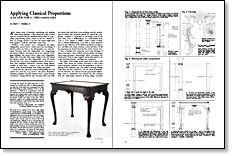Applying Classical Proportions
A tea table built to 18th-century rules
Synopsis: Mack S. Headley, Jr., built a tea table using the five classical orders, a geometric proportioning system. After researching Williamsburg builder Peter Scott’s work, he arrived at a design that he shows here. He used proportions of the Ionic order to determine the height, and he shows how he decided on the carvings and derived the table’s other proportions. He began with a square the height of the table and then drew a second square the height of the entablature. Those two squares define the major positive and negative spaces of the table. The Ionic method also determines the skirt depth, knee block, and leg diameter.
After sixteen years of restoring, reproducing and studying 18th-century furniture, I have joined the ranks of those who are convinced that the traditional artisan relied on a geometric proportioning system, based on the five classical orders. As a design exercise to test how the system might have been applied, I built the small table shown here.
Evidence of the system’s use is widespread, but vague. Chippendale, quoted below, dearly stated that knowledge of the five orders was basic to the cabinetmaker’s art. Some furniture historians insist that Chippendale was exaggerating, but Marcus Wiffen’s observations about the character of Virginia buildings, also quoted below, agree with Chippendale. Many 18th- and early 19th-century design books also feature the classical orders, but, like Chippendale, don’t tell exactly how the rules were used in designing furniture. This seems to have been privileged information, imparted during apprenticeship. In earlier times, I suspect it was one of the guarded secrets of the furnituremaking and architectural guilds.
I found that the only path toward understanding how the system was used was to go back to the pieces themselves. Surviving examples of period furniture have a great diversity of character, varying with the time and place they were built, the current style (and how it was evolving), and the environment in which they would be placed. To unravel the complexity, I decided to concentrate on the design work of one man, Peter Scott, a Williamsburg, Va., cabinetmaker from 1722 to 1776. Thanks to Wallace Gusler, curator of furniture at Colonial Williamsburg, I was able to study numerous pieces in the collection. Scott’s lifetime production is impressive, and filled with subtle variation, control and flair. Yet all his proportions are derived from the five orders: Tuscan, Doric, Ionic, Corinthian and Composite. Upon scale drawings of many of his pieces I have walked with my dividers for hours, discovering geometric relationships which encompass the whole piece—from its major negative and positive spaces to its actual structural elements, moldings and ornaments.
The origins of this design system reach back at least to the Greeks, from whom the Romans borrowed it. And it later served European craftsmen from the Renaissance to the beginning of the Industrial Age. The earliest surviving writings come from the first century AD, The Ten Books of Architecture by Vitruvius. He explains that the proportional relationships used in architecture were derived by “the ancients” from the relationships observed in living things. Leonardo da Vinci’s famous drawing of a spread-eagled man contained within a circle is based on instructions found in Vitruvius, who enumerates other ideal proportions as well.
From Fine Woodworking #43
For the full article, download the PDF below:
Fine Woodworking Recommended Products

Estwing Dead-Blow Mallet

Circle Guide

Stanley Powerlock 16-ft. tape measure





















Log in or create an account to post a comment.
Sign up Log in